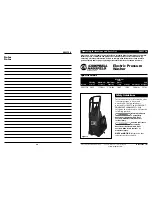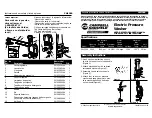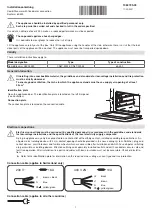
Strong and forceful steam comes
out from the pressure release valve
with or without drops of water
condensation.
Steam comes out from the edge of
the lid.
There is leakage through the
gasket.
The cover does not open after
cooling.
The pressure cooker cannot be
opened after cooking.
Food is under-cooked.
Food is over-cooked.
The pressure cooker boils dry.
1. The burner heat is too high.
2. The pressure release valve is dirty or
clogged.
3. The pressure release valve is
malfunctioning.
1. The pressure cooker is too full.
2. The pressure cooker is not closed
properly.
3. The gasket is dirty, worn or not in
the correct position.
1. Gasket is not properly positioned in
the cover.
2. Gasket is worn or old.
There is water on top of one or both of
the auto-lock valves.
Pressure within the cooker is not
released fully.
1. Cooking time is too short.
2. Pressure is quickly released from the
pressure cooker using the fast pressure
release method while cooking items
such as meat, etc.
1. Cooking time is too long.
2. Pressure within the pressure cooker is
released using the slow release method
while preparing items such as seafood, etc.
3. The slow pressure release method was
inadequately used to release the pressure.
1. There is leakage through the gasket.
2. Cooking time is too long and/or
cooking level is too high.
3. Insufficient water.
1. Reduce the burner heat to maintain a
gentle and steady stream of steam.
2. Clean the pressure release valve following
“Pressure Release Valve Maintenance and
Cleaning” instructions.
3. Replace the pressure release valve.
1. Never fill the pressure cooker more than
2/3 full or ½ full when cooking liquids or
food that froth and expand during cooking.
2. Close the pressure cooker so that a tight
seal is created between the cooker body and
the lid.
3. Clean the gasket and re-insert it in the
correct position. Inspect and replace the
gasket if required.
1. Reposition the gasket as shown in
“OPERATING INSTRUCTIONS (2) GASKET”.
2. Replace with a new gasket by going to
www.lagostina.ca or telephoning 1-800-263-
4067.
Gently tap the top of the auto-lock valves in
order to make them descend.
Use normal or fast pressure release methods
to cool the pressure cooker and release all
remaining pressure. Now try to open the
pressure cooker.
1. Allow the food to cook for appropriate
cooking time. (See section ”Table of Cooking
Times” for more detailed instructions). If
food is still under-cooked, extend cooking
time by approximately 1-2 minutes and cook
under pressure, or simmer without lid until
desired results are achieved.
2. Allow the cooker to cool and release the
pressure automatically using the slow
pressure release method.
1. Always check the cooking times in the
recipe.
2. Shorten the cooking time by at lease 1-2
minutes.
3. Use the normal or fast pressure release
method so that pressure drops immediately.
1. Always ensure gasket is properly inserted.
2. Please refer to Table of Cooking Times.
3. Always ensure that there is a minimum of
¼ litre (1 cup) of water or some other liquid
in the pressure cooker in order that steam
can be produced.
PROBLEM
POSSIBLE CAUSES
SOLUTIONS
15
CAUTION: ONLY USE AUTHENTIC LAGOSTINA TICINO PRESSURE COOKER REPLACEMENT PARTS FOR THIS PRESSURE COOKER.
THE USE OF ANY UNAUTHORIZED PARTS MAY CAUSE UNIT FAILURE AND/OR INJURY AND WILL VOID THE WARRANTY.
FOR LAGOSTINA REPLACEMENT PARTS
PLEASE CALL OUR CUSTOMER SATISFACTION HOTLINE
1-800-263-4067 or visit www.lagostina.ca
TICINOBOOKLET ENGLISH_Mise en page 1 2013-10-15 15:27 Page17




































